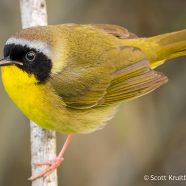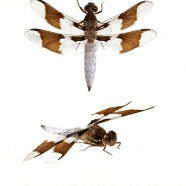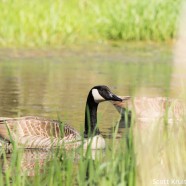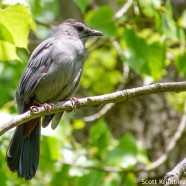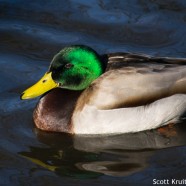Common Yellowthroat
This male Common Yellowthroat (Geothlypis trichas) and I are rather close…or at least we were for about 30 seconds on a recent May morning. This bird is a migrant, though you may end up with a resident in a yard near you. Their common name does betray their abundance, and gardens, marshes, fields, forests or anywhere they can skulk about in dense, low vegetation works for them. Being a habitat generalist has helped the species end up as one of our most common warblers. It also makes them a frequent target of Brown-headed Cowbirds and brood parasitism, like the abundant Yellow Warbler....
Read MoreCommon Whitetail
Here’s the Common Whitetail (Plathemis lydia), certainly one of the more common dragonflies found in ponds, lakes, and waterways at this time of the year. More and more species are being seen flying everyday in the Northeast and Sean will be trying to show you as many as he can in beautiful displays like this one. Photographed by RTPI Affiliate Sean Graesser for the Meet Your Neighbours global biodiversity project in Connecticut for the Roger Tory Peterson Institute of Natural History.
Read MoreCanada Goose Pair
There is no more common and known waterfowl species than the Canada Goose (Branta canadensis) for most of us year-round, but even this bird, seen as a pest by some as they soil parks and cover golf courses, must live and breed. This is a pair at a local pond that was likely about to nest. They really have a handsome look to them, if you stop to take it in…and I appreciate them! Scott Kruitbosch Conservation & Outreach Coordinator
Read MoreGray Catbirds Coming
We will soon be inundated by the deceptive and incorrect sound of felines as the Gray Catbird returns in full force to our neighborhoods across America. They really have about as literal a common name as any bird. Apart from their gray bodies and black cap you can also see a hint of the rusty-colored feathers under these bird’s tails. Meow to you, too.
Read MoreDrake Mallard
Sometimes you have to stop and appreciate the “classics” – or more specifically, a bird like the very common Mallard duck. The drake has a stunning appearance, with its gorgeous plumage often being overlooked because people (like me) see so very many of them. Here’s to them! Scott Kruitbosch Conservation & Outreach Coordinator
Read More



